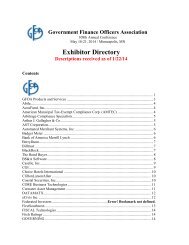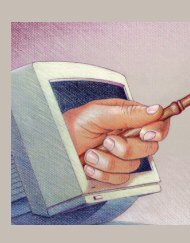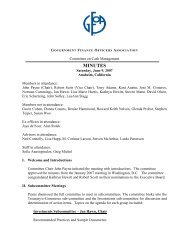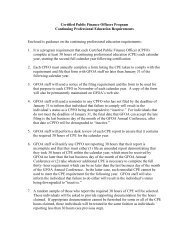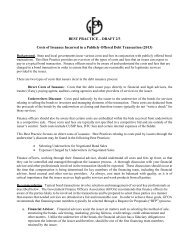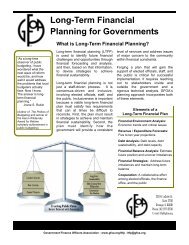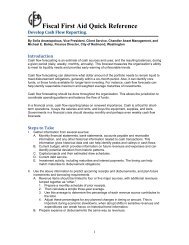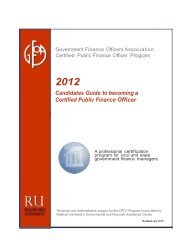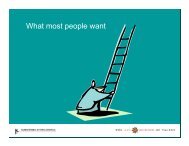Purchasing Cards Come of Age - Government Finance Officers ...
Purchasing Cards Come of Age - Government Finance Officers ...
Purchasing Cards Come of Age - Government Finance Officers ...
You also want an ePaper? Increase the reach of your titles
YUMPU automatically turns print PDFs into web optimized ePapers that Google loves.
<strong>Purchasing</strong> card spending by state and local governments more than doubled<br />
between 1998 and 2001, fueled by greater card distribution among public<br />
employees and fewer restrictions on usage.<br />
<strong>Purchasing</strong> <strong>Cards</strong> <strong>Come</strong> <strong>of</strong> <strong>Age</strong>:<br />
A Survey <strong>of</strong> State and<br />
Local <strong>Government</strong>s<br />
By Richard J. Palmer, Mahendra Gupta, Antonio Davila, and Tim Mills<br />
<strong>Purchasing</strong> cards were developed in the late 1980s as a means<br />
<strong>of</strong> helping federal government agencies acquire small-dollar<br />
goods without subjecting their vendors to payment delays<br />
associated with the bureaucratic procurement processes at that<br />
time. In addition to expediting payment, purchasing cards have<br />
been found to have numerous other important benefits, principally<br />
relating to the reduction or elimination <strong>of</strong> the paperwork plague<br />
associated with requisitions, purchase orders, and invoices for<br />
thousands <strong>of</strong> small-dollar transactions. 1 The elimination <strong>of</strong> the<br />
bureaucratic red tape typically required to process small-dollar<br />
purchases empowers procurement and payables personnel to focus<br />
on issues <strong>of</strong> greater importance to taxpayers, such as negotiating<br />
the best terms on high-dollar expenditures.<br />
These benefits account for the $12.3 billion worth <strong>of</strong> purchasing<br />
card spending by federal government agencies in 2000. 2 Based on<br />
an average transaction size <strong>of</strong> $524, more than 23 million smalldollar<br />
transactions were shifted from a paper-based procurement<br />
process to a card-based process. 3 Given the General Services<br />
Administration’s estimate that federal agencies save more than $50<br />
in administrative costs per purchasing card transaction, federal<br />
government savings attributable to purchasing cards totaled $1.2<br />
billion in 2000. 4 Rebates from card issuers to the federal government<br />
for discounts paid by vendors generated another $55 million<br />
in 1999 alone. 5<br />
Although the growth and benefits <strong>of</strong> federal government usage <strong>of</strong><br />
purchasing cards have been widely reported, little is known about<br />
the effects <strong>of</strong> these cards on state and local government operations.<br />
Specifically, no study to date has examined the impact <strong>of</strong> purchasing<br />
cards on the cost, efficiency, or cycle times <strong>of</strong> state and local<br />
government procurement practices. This article fills this void by<br />
summarizing the results <strong>of</strong> a survey on purchasing card usage by<br />
state and local (i.e., city and county) governments. The purpose <strong>of</strong><br />
the article is fourfold: (1) identify the benefits associated with state<br />
and local government usage <strong>of</strong> purchasing cards, (2) document<br />
both current and projected purchasing card spending patterns <strong>of</strong><br />
state and local governments, (3) establish benchmark data by<br />
which state and local governments can evaluate the success <strong>of</strong> their<br />
purchasing card programs, and (4) identify “best practices” <strong>of</strong> successful<br />
state and local government purchasing card programs.<br />
Survey Methodology and Response Rates<br />
In October and November <strong>of</strong> 2000, 2,551 corporate purchasing<br />
card benchmark surveys were distributed to the institutional clients<br />
<strong>of</strong> 14 major purchasing card issuers. 6 Three hundred and nine<br />
responses were returned for a response rate <strong>of</strong> 12.3 percent. 7 A late<br />
mailing <strong>of</strong> 500 surveys with a constricted response time yielded an<br />
additional 24 responses. Four responses were dropped from the<br />
database because the participants had yet to issue purchasing cards<br />
or they did not provide any usable information. The final survey<br />
database consisted <strong>of</strong> 329 usable responses received before February<br />
2001. One hundred and fifty respondents were governmental users<br />
<strong>of</strong> purchasing cards, including 50 (15.2 percent) city or county governments<br />
and 29 (8.8 percent) state government agencies.<br />
Current <strong>Purchasing</strong> Card Usage by State <strong>Age</strong>ncies<br />
Overall, the impact <strong>of</strong> purchasing cards on state government has<br />
been significant. State agencies report an average per transaction<br />
savings in administrative paperwork handling <strong>of</strong> $101 and an average<br />
reduction <strong>of</strong> seven days in the time elapsed from determination<br />
<strong>of</strong> employee need to the receipt <strong>of</strong> the ordered good. Exhibit 1 provides<br />
a comparison <strong>of</strong> 1998 and 2001 state purchasing card statistics.<br />
The average state agency purchasing card spending increased<br />
by 227 percent in the 29-month period between surveys, which is<br />
the largest increase <strong>of</strong> any survey respondent group—government<br />
or corporate.<br />
This phenomenal growth in purchasing card usage by state agencies<br />
can be attributed to three other survey statistics. First, average<br />
state agency spending per transaction increased by 45 percent—<br />
from $182 to $264. The $264 figure is higher than any corporate<br />
respondent group and second only to federal government agency<br />
activity. Second, the average percentage <strong>of</strong> state agency employees<br />
authorized as cardholders more than doubled from 29 months previous,<br />
increasing from 4.2 percent to 9.5 percent. And third, the<br />
percentage <strong>of</strong> active cards (cards that had been used in the last<br />
month) at state agencies grew from 61 to 76 percent.<br />
Not everything about state agency usage <strong>of</strong> purchasing cards was<br />
on an upswing. Exhibit 1 shows that the number <strong>of</strong> transactions<br />
per card dropped from 4.7 to 4.1 per month. This fall<strong>of</strong>f is attributed<br />
to the fact that greater purchasing card distribution necessari-<br />
6 AUGUST 2002 GOVERNMENT FINANCE REVIEW
Exhibit 1<br />
PURCHASING CARD USAGE BY STATE AGENCIES, 1998 AND 2001<br />
Percentage<br />
1998 2001 Increase<br />
Measure (n=10) (n=29) (Decrease)<br />
Average number <strong>of</strong> unit employees 16,808 15,129 (10)<br />
Average number <strong>of</strong> unit purchasing cards 552 1,649 199<br />
Mean monthly purchasing card spending $550,152 $1,797,769 227<br />
Median monthly purchasing card spending $7,975 $295,761 3,609<br />
Monthly spending per card $863 $1,090 26<br />
Monthly transactions per card 4.7 4.1 (13)<br />
Spending per transaction $182 $264 45<br />
Cardholders as a percentage <strong>of</strong> employees 4.2% 9.5% 126<br />
Percentage <strong>of</strong> cards active 61% 76% 25<br />
Percentage <strong>of</strong> small-dollar purchases ($2,000 or less) 2% 45% 105<br />
transacted via purchasing card<br />
ly results in card usage at increasingly lower levels <strong>of</strong> the organization.<br />
Many governments have lower spending limits and fewer<br />
allowable spending categories for personnel at lower levels <strong>of</strong> the<br />
organization.The reduction in the number <strong>of</strong> transactions per card<br />
is probably due to the fact that greater card distribution ultimately<br />
translates into higher numbers <strong>of</strong> lower-level employees possessing<br />
and using purchasing cards. It is not uncommon for organizations<br />
to restrict usage by lower-level personnel by imposing spending limits<br />
or constraining allowable categories <strong>of</strong> purchases.<br />
In sum, state agencies have tripled purchasing card spending by<br />
providing more cards to employees who are using those cards to<br />
buy goods that are more expensive than those purchased 29 months<br />
ago. On average, the state agency respondents use their purchasing<br />
cards 81,131 times per year to pay for $21.6 million worth <strong>of</strong><br />
goods and services. Assuming that the average respondent-reported<br />
administrative cost savings <strong>of</strong> $101 per transaction is reasonable,<br />
purchasing card usage generates savings <strong>of</strong> $8.2 million annually<br />
per state agency. These savings can be used for tax cuts or to free up<br />
government resources for services that add greater value to society.<br />
Projected <strong>Purchasing</strong> Card Usage by State <strong>Age</strong>ncies<br />
Exhibit 2 shows current and projected state agency purchasing<br />
card usage in both dollar volume and as a percentage <strong>of</strong> total spending<br />
by category. Overall, purchasing card spending is expected to<br />
grow 37 percent over the next two years, driving up purchasing<br />
card usage as a percentage <strong>of</strong> total state agency spending from 4<br />
percent to 6 percent by 2003. The expected growth in purchasing<br />
card spending by state agencies is lower than the experience <strong>of</strong> the<br />
past two years (see Exhibit 1) and lower than the expected growth<br />
for corporate respondents. 8<br />
These expectations suggest that the aggressive purchasing card<br />
usage <strong>of</strong> the past few years may have reached a plateau.<br />
Nevertheless, if 4 percent <strong>of</strong> all state spending ($998 billion) were<br />
transacted via purchasing cards, states would represent a $40 bil-<br />
Exhibit 2<br />
CURRENT AND PROJECTED PURCHASING CARD SPENDING BY STATE AGENCIES<br />
Projected<br />
Current Current <strong>Purchasing</strong> Current Projected<br />
Total <strong>Purchasing</strong> Card Projected Spending Spending<br />
Monthly Card Spending Dollar Projected Captured by Captured by<br />
Commodity Spending Spending 2 Years Out Increase Percent <strong>Purchasing</strong> <strong>Purchasing</strong><br />
Category (000s) (000s) (000s) (000s) Increase <strong>Cards</strong> <strong>Cards</strong><br />
Utilities $1,052,600 $147,100 $189,200 $42,100 29% 14% 18%<br />
MRO 1,977,600 138,600 217,800 79,200 57 7 11<br />
Travel 88,800 36,200 40,100 3,900 11 41 45<br />
Leases 240,700 36,000 45,500 9,500 26 15 19<br />
Office products 23,800 10,900 12,000 1,100 10 46 50<br />
Services 83,200 8,300 11,600 3,300 40 10 14<br />
Freight 14,300 700 1,300 600 86 5 9<br />
Other 13,100 600 1,800 1,200 200 5 14<br />
Computer 1,100 300 300 0 0 27 27<br />
Capital 127,900 200 300 100 50 0 0<br />
Postage 2,600 100 200 100 100 4 8<br />
Direct material 4,189,400 100 100 0 0 0 0<br />
Temp labor 200 0 0 0 0 0 0<br />
Benefits 1,563,300 0 0 0 0 0 0<br />
TOTAL $9,378,600 $379,100 $520,200 $141,100 37% 4% 6%<br />
GOVERNMENT FINANCE REVIEW AUGUST 2002 7
Exhibit 3<br />
lion market for card issuers. 9 Given the average transaction size <strong>of</strong><br />
$264 and administrative cost savings <strong>of</strong> $101 per transaction, this<br />
$40 billion in annual purchasing card spending translates into<br />
151.5 million annual transactions for collective cost savings to<br />
states <strong>of</strong> $15.3 billion.<br />
Exhibit 2 shows that the bulk <strong>of</strong> state agency purchasing card<br />
spending goes to <strong>of</strong>fices supplies, travel and entertainment, computers,<br />
lease payments, and utility bills. The greatest penetration <strong>of</strong><br />
purchasing cards is in the category <strong>of</strong> <strong>of</strong>fice supplies, where state<br />
agencies are expected to acquire half <strong>of</strong> these products with purchasing<br />
cards by 2003.<br />
Exhibit 4<br />
PURCHASING CARD USAGE BY LOCAL GOVERNMENTS, 1998 AND 2001<br />
Percentage<br />
1998 2001 Increase<br />
Measure (n=7) (n=50) (Decrease)<br />
Average number <strong>of</strong> employees 2,323 3,412 47%<br />
Average number <strong>of</strong> purchasing cards 104 342 229<br />
Average monthly purchasing card spending $78,014 $194,981 150<br />
Median monthly purchasing card spending $66,013 $110,000 67<br />
Monthly spending per card $747 $578 (23)<br />
Monthly transactions per card 4.3 3.4 (21)<br />
Spending per transaction $173 $168 (3)<br />
Cardholders as a percentage <strong>of</strong> employees 4.1% 9.5% 132<br />
Percentage <strong>of</strong> cards active 77% 83% 8<br />
Percentage <strong>of</strong> small-dollar purchases ($2,000 24% 38% 58<br />
or less) transacted via purchasing card<br />
Current <strong>Purchasing</strong> Card Usage by Local <strong>Government</strong>s<br />
The impact <strong>of</strong> purchasing cards on city and county government<br />
operations also has been significant. Cities and counties report an<br />
average per transaction savings in administrative paperwork handling<br />
<strong>of</strong> $46 and an average<br />
reduction <strong>of</strong> 5.4 days in the<br />
time elapsed from need<br />
determination to receipt <strong>of</strong><br />
the ordered good. Exhibit 3<br />
provides a comparison <strong>of</strong><br />
1998 and 2001 local government<br />
purchasing card<br />
statistics. Average city/county<br />
purchasing card spending<br />
increased by 150 percent in<br />
the 29-month period<br />
between surveys. This<br />
growth is primarily attributed<br />
to a modest increase in<br />
the percentage <strong>of</strong> cards that<br />
are active (from 77 to 83<br />
percent) and to a significant<br />
increase (from 4.1 to 9.5<br />
percent) in the average percentage<br />
<strong>of</strong> city/county<br />
employees who are cardholders. As was the case for state agencies,<br />
this latter percentage more than doubled from 29 months previous.<br />
Other aspects <strong>of</strong> local government purchasing card spending<br />
moved in the opposite direction. The number <strong>of</strong> transactions per<br />
card dropped from 4.3 to 3.4 per month, while the average spending<br />
per transaction decreased slightly from $173 to $168. These<br />
two facts combined created the lowest average monthly spending<br />
per purchasing card ($578) <strong>of</strong> all respondent groups—corporate or<br />
government. As noted above, the reduction in the number <strong>of</strong><br />
monthly transactions per card may be attributable to the fact that<br />
greater card distribution ultimately results in greater numbers <strong>of</strong><br />
lower-level employees possessing and using purchasing cards, typically<br />
with smaller spending allowances and more restrictions on<br />
allowable purchases.<br />
In sum, cities and counties have more than doubled purchasing<br />
card spending, primarily by increasing the percentage <strong>of</strong> their<br />
CURRENT AND PROJECTED PURCHASING CARD SPENDING BY LOCAL GOVERNMENTS<br />
Projected<br />
Current Current <strong>Purchasing</strong> Current Projected<br />
Total <strong>Purchasing</strong> Card Projected Spending Spending<br />
Monthly Card Spending Dollar Projected Captured by Captured by<br />
Commodity Spending Spending 2 Years Out Increase Percent <strong>Purchasing</strong> <strong>Purchasing</strong><br />
Category (000s) (000s) (000s) (000s) Increase <strong>Cards</strong> <strong>Cards</strong><br />
Utilities $ 7,825 $1,202 $1,563 $ 361 30% 15% 20%<br />
MRO 995 382 257 (125) (33) 38 26<br />
Travel 6,530 88 517 429 488 1 8<br />
Leases 12,010 83 497 414 499 1 4<br />
Office products 450 62 121 59 95 14 27<br />
Services 3,610 50 125 75 150 1 3<br />
Freight 4,780 48 423 375 781 1 9<br />
Other 4,630 44 52 8 18 1 1<br />
Computer 660 27 256 229 848 4 39<br />
Capital 580 5 1 (4) (80) 1 0<br />
Postage 50 5 10 5 100 10 20<br />
Direct material 550 5 14 9 180 1 3<br />
Temp labor 1,045 3 9 6 200 0 1<br />
Benefits 8,620 0 0 0 0 0 0<br />
TOTAL $52,335 $2,004 $3,845 $1,841 92% 4% 7%<br />
8 AUGUST 2002 GOVERNMENT FINANCE REVIEW
employees who are issued purchasing cards. On average, local government<br />
respondents use their purchasing cards 13,954 times per<br />
year to pay for $2.3 million worth <strong>of</strong> goods and services. Assuming<br />
that the average respondent-reported administrative cost savings <strong>of</strong><br />
$46 per transaction is reasonable, purchasing card usage generates<br />
annual savings <strong>of</strong> $641,866 per city or county.<br />
Projected <strong>Purchasing</strong> Card Usage by Local <strong>Government</strong>s<br />
Exhibit 4 shows current and projected city/county purchasing<br />
card spending in both dollar volume and as a percentage <strong>of</strong> spending<br />
by commodity category. Overall, purchasing card spending is<br />
expected to grow 92 percent over the next two years, driving up<br />
purchasing card spending from 4 percent to 7 percent <strong>of</strong> total<br />
city/county spending by 2003. Although the expected growth in<br />
purchasing card spending by cities and counties is lower than the<br />
experience <strong>of</strong> the past two years (see Exhibit 3), purchasing cards<br />
are playing an increasingly important role in local government procurement.<br />
The greatest penetration <strong>of</strong> purchasing cards into city/county<br />
spending is in the categories <strong>of</strong> <strong>of</strong>fice supplies and maintenance,<br />
repairs, and operating goods. Currently, cities and counties use purchasing<br />
cards to pay for 38 and 15 percent <strong>of</strong> the products acquired<br />
in these categories, respectively. In dollar terms, <strong>of</strong>fice products and<br />
MRO account for 79 percent <strong>of</strong> current city/county purchasing<br />
card spending. Because <strong>of</strong> the significant increases in expected purchasing<br />
card spending for other commodities (e.g., capital goods,<br />
utilities, services, and computers), <strong>of</strong>fice supplies and MRO should<br />
account for less than half <strong>of</strong> this spending by 2003.<br />
Understanding State and Local <strong>Government</strong> <strong>Purchasing</strong><br />
Card Usage<br />
One goal <strong>of</strong> the study was to gain insights into why some state<br />
and local governments shift millions <strong>of</strong> dollars <strong>of</strong> spending to purchasing<br />
cards, while others only thousands. Of course, purchasing<br />
card spending is a function <strong>of</strong> a government’s size and the age <strong>of</strong> its<br />
purchasing card program. A simple demonstration sample that controls<br />
for size and age revealed some important differences between<br />
“successful” and “unsuccessful” purchasing card programs.<br />
Exhibit 5 compares organizational and program performance<br />
statistics from a selected sample <strong>of</strong> state and local governments.<br />
This respondent base was divided into two groups: a “high-spend”<br />
group and a “low-spend” group. The high-spend group is characterized<br />
by monthly purchasing card spending <strong>of</strong> $750,000 or more,<br />
and the low-spend group by monthly spending <strong>of</strong> less than<br />
$750,000. To ensure that the units within each group were otherwise<br />
homogenous, all programs that were less than one year old<br />
were eliminated, as were all programs with less than 3,000 or more<br />
than 50,000 employees. This resulted in two groups that differ in<br />
terms <strong>of</strong> monthly purchasing card spending, but are not significantly<br />
different in terms <strong>of</strong> size (as measured by number <strong>of</strong> employees)<br />
or program age.<br />
The differences between the high-spend and low-spend groups<br />
are indicative <strong>of</strong> some <strong>of</strong> the best practices in state and local government<br />
purchasing card programs. The most striking difference is<br />
that high-spend organizations issue purchasing cards to a significantly<br />
larger percentage <strong>of</strong> their employees than low-spend organizations<br />
(13 percent versus 5 percent). In raw numbers, high-spend<br />
organizations average more than 2.5 times as many purchasing<br />
cards as low-spend organizations. The analysis also revealed that<br />
although high-spend cardholders use their cards less frequently<br />
than their low-spend counterparts, they spend significantly more<br />
per transaction ($289 versus $119).<br />
Exhibit 5 also shows that the benefits accruing to high-spend<br />
organizations by virtue <strong>of</strong> employee card spending behavior are significantly<br />
greater those <strong>of</strong> low-spend organizations. High-spend<br />
entities report headcount reductions more than seven times greater<br />
than low-spend organizations. High-spend organizations were able<br />
to reduce or redeploy an average <strong>of</strong> 2.9 full-time equivalent staff by<br />
shifting transactions to purchasing cards, compared to just .4 for<br />
low-spend organizations. However, higher levels <strong>of</strong> spending were<br />
not reflected in the percentage <strong>of</strong> organizations sharing card issuer<br />
revenue. This fact seems to suggest that the agency banking rela-<br />
Exhibit 5<br />
DIFFERENCES IN PURCHASING CARD USAGE BETWEEN LOW- AND HIGH-SPEND GOVERNMENTS<br />
State & Local<br />
State & Local<br />
Low-Spend Group High-Spend Group<br />
Measure (n=14) (n=8)<br />
Average number <strong>of</strong> employees 10,071 10,621<br />
Average monthly purchasing card spending $370,603 $1,728,116<br />
Average monthly purchasing card transactions 3,107 5,977<br />
Average number <strong>of</strong> cards 572 1,477<br />
Average monthly spending per card $647 $1,169<br />
Average monthly transactions per cardholder 5.4 4.0<br />
Average transaction size $119 $289<br />
Cardholders as a percentage <strong>of</strong> employees 5% 13%<br />
Percentage <strong>of</strong> small-dollar purchases ($2,000 or less) 34% 54%<br />
transacted via purchasing card<br />
Percentage <strong>of</strong> cards active 89% 88%<br />
Average percent reduction/redeployment <strong>of</strong> purchasing and .4 2.9<br />
accounts payable FTEs<br />
Percent sharing in card provider's revenue associated with 42% 43%<br />
purchasing card use<br />
No statistically significant difference in the size <strong>of</strong> the agencies (as measured by the number <strong>of</strong> employees) in each group. <strong>Age</strong>ncies reporting<br />
fewer than 3,000 or more than 50,000 employees, or purchasing card programs less than a year old, were excluded from this sub-sample<br />
to minimize group differences while maintaining sufficient observations to sustain a valid comparison.<br />
GOVERNMENT FINANCE REVIEW AUGUST 2002 9
Exhibit 6<br />
CONTROL DIFFERENCES BETWEEN LOW- AND HIGH-SPEND GOVERNMENTS<br />
State & Local<br />
Low-Spend Group<br />
Control Differences (n=14) (n=8)<br />
Mean per transaction spending limit $1,342 $1,393<br />
Mean monthly spending limit $7,750 $8,571<br />
Block fuel and auto purchases 54% 14%<br />
Allow capital purchases 28% 63%<br />
Single card for both travel and purchases 36% 63%<br />
<strong>of</strong> goods and services<br />
Refusal to process requisitions that could 28% 75%<br />
be bought with a purchasing card<br />
tionships are defined at levels higher up in the organization.<br />
Organizational policies and procedures must support active use<br />
<strong>of</strong> purchasing cards. Exhibit 6 presents an analysis that identifies<br />
key differences in card-related policies and procedures between the<br />
two groups. There is a modest $821 difference between the groups<br />
in terms <strong>of</strong> the average spending allowed per month. High-spend<br />
units place fewer restrictions on purchasing card spending than<br />
their low-spend counterparts. Specifically, a much higher percentage<br />
<strong>of</strong> high-spend governments permit the use <strong>of</strong> purchasing cards<br />
for capital goods, travel and entertainment, and fuel and automotive<br />
purchases. Likewise, high-spend organizations are much more<br />
likely than low-spend organizations to refuse to process requisitions<br />
for products that can be bought with a purchasing card.<br />
High purchasing card spending apparently comes at a cost to<br />
management’s sense <strong>of</strong> control. Managers at high-spend state and<br />
local governments were uniformly more concerned than their lowspend<br />
counterparts that purchasing card spending would undermine<br />
their ability to control departmental spending. They were also<br />
more concerned that employees would pay too much for goods and<br />
services, make duplicate purchases, buy products with unnecessary<br />
bells and whistles, and make unapproved purchases requiring corrective<br />
action. By contrast, low-spend managers were more concerned<br />
that spending limits and other controls prevented them from<br />
realizing the benefits <strong>of</strong> purchasing cards.<br />
Conclusion<br />
The purpose <strong>of</strong> this article was to present the results <strong>of</strong> a survey<br />
on state and local government use <strong>of</strong> purchasing cards. <strong>Purchasing</strong><br />
card spending at these levels <strong>of</strong> government more than doubled<br />
between 1998 and 2001, generating average annual administrative<br />
cost savings <strong>of</strong> $8.2 million per state agency and $641,866 per city<br />
or county. If all state agencies used purchasing cards to the extent<br />
that the survey respondents are using them, approximately $40 billion<br />
in annual state spending could be shifted to the cards, saving<br />
states more than $15.3 billion in non-value-adding paperwork processing<br />
charges. Projected growth in purchasing card spending is<br />
expected to be modest for state agencies, yet strong among cities<br />
and counties.<br />
The key drivers <strong>of</strong> purchasing card program growth for state and<br />
local government have been the dissemination <strong>of</strong> purchasing cards<br />
to a larger percentage <strong>of</strong> the employee base and the opening <strong>of</strong><br />
spending categories that enable the acquisition <strong>of</strong> higher dollar<br />
goods. High-spending governments have a greater tendency to use<br />
administrative policies to force small-dollar spending to the purchasing<br />
card. These same governments are significantly more likely<br />
to realize hard-dollar savings from purchasing card usage. At the<br />
same time, managers at these governments express greater concern<br />
over losing control over employee spending behavior.<br />
NOTES<br />
1<br />
See, for example, R. Palmer, L. Green, and M.<br />
Ventura, “Are Corporate Procurement <strong>Cards</strong><br />
for You?” Management Accounting<br />
State & Local<br />
(September 1996): 23-30.<br />
2<br />
Lisa Daigle, “A Rough Ride Inside the Beltway,”<br />
Credit Card Management 14 (July 2001):<br />
High-Spend Group<br />
4, 48-54. For perspective on this growth, consider<br />
that in 1989 the Department <strong>of</strong> Defense<br />
used 10,000 purchasing cards to pay for 2,000<br />
transactions totaling $460,000. By 2000, the<br />
Department <strong>of</strong> Defense used purchasing cards<br />
to engage in approximately 10 million transactions<br />
for $5.5 billion (see www.purchasecard.<br />
saalt.army.mil/00metrics.htm.<br />
3<br />
Ibid. However, it should be noted that other<br />
reports and studies show the average federal<br />
government purchase transaction size to be<br />
$400 (see, for example, www.napcp.<br />
org/palmersurvey).<br />
4<br />
Anne Laurent, “Trump Card,” <strong>Government</strong> Executive (May 2000): 30-<br />
38.<br />
5<br />
Ibid.<br />
6<br />
Bank participants included Bank <strong>of</strong> America, Bank One, Canadian<br />
Imperial Bank <strong>of</strong> Commerce, Chase Manhattan, Citibank, Firstar,<br />
National City Bank, GE Capital Financial, Mellon Bank, PNC Bank,<br />
SunTrust, USBank, Wachovia, and Wells Fargo. It should be noted that<br />
the results <strong>of</strong> the survey are based on purchasing card spending patterns<br />
and card-related organizational activities <strong>of</strong> the customers <strong>of</strong> the 14 participating<br />
card issuers. The results may not necessarily reflect the purchasing<br />
card spending and card-related organizational activities <strong>of</strong> customers<br />
<strong>of</strong> other non-participating purchasing card issuers.<br />
7<br />
A similar, but smaller, study was performed in August <strong>of</strong> 1998. That study<br />
was mailed to 1,034 purchasing card users <strong>of</strong> seven major card issuers<br />
(American Express, Chase Manhattan, First Chicago NBD, GE Capital<br />
Financial, PNC Bank, Wachovia, and Wells Fargo). One hundred and<br />
eighty-eight usable surveys were returned for an overall response rate <strong>of</strong><br />
18.3 percent.<br />
8<br />
Expected purchasing card growth by corporate respondents ranged from<br />
100 to 400 percent according to R. Palmer, M. Gupta, and A. Davila,<br />
“Corporate <strong>Purchasing</strong> Card Benchmark Survey,” www.napcp.org/palmersurvey.<br />
9<br />
U.S. Census Bureau <strong>Government</strong>s Division, “States Ranked by Revenues and<br />
Expenditure Total Amount and Per Capita Total Amount: 1999,” (May 2,<br />
2001). Also available at www.census.gov/ftp/pub/govs/state/99rank.html.<br />
RICHARD J. PALMER is the Lumpkin Distinguished Pr<strong>of</strong>essor <strong>of</strong> Business at<br />
Eastern Illinois University. Dr. Palmer is a frequent speaker at purchasing<br />
card training and user conferences, and he has authored more than 40 publications<br />
on cost management and electronic commerce topics, including<br />
award-winning studies on industry use <strong>of</strong> corporate purchasing cards.<br />
MAHENDRA GUPTA is an associate pr<strong>of</strong>essor at the Olin School <strong>of</strong> Business at<br />
Washington University in St. Louis. He received his doctorate from<br />
Stanford University in 1990 and his master’s degree from Carnegie Mellon<br />
University in 1981. Pr<strong>of</strong>essor Gupta currently studies issues in strategic cost<br />
management, benchmarking, and performance measurement. ANTONIO<br />
DAVILA is an assistant pr<strong>of</strong>essor at the Graduate School <strong>of</strong> Business at<br />
Stanford University. He received his doctorate from the Harvard School <strong>of</strong><br />
Business in 1998 and a telecommunications engineering degree from the<br />
University <strong>of</strong> Catalunya, Spain. Dr. Davila’s research interests include the<br />
design and use <strong>of</strong> cost management systems, control systems for implementing<br />
strategy, and performance measurement. TIM MILLS is an associate pr<strong>of</strong>essor<br />
at Eastern Illinois University. He received his doctorate from<br />
Louisiana Tech in 1989. Dr. Mills’ research interest is governmental<br />
accounting.<br />
10 AUGUST 2002 GOVERNMENT FINANCE REVIEW



